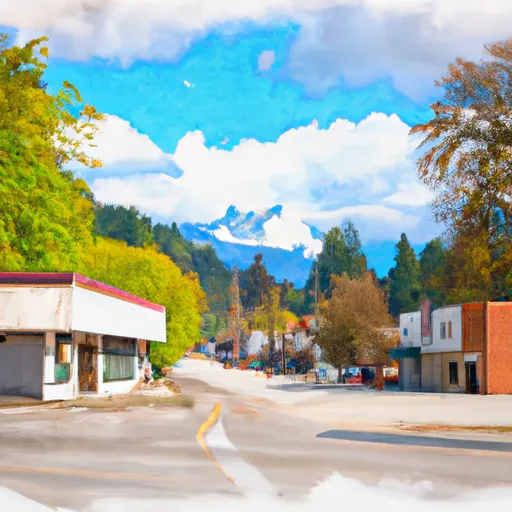-
 Snoflo Premium
Snoflo Premium
Get unlimited access to all our content
With no Ad interruptions! - Start Your Free Trial Login with existing account
Marblemount
Eden Index
Climate
4.2
•
Recreation
5.2
•
Community
•
Safeguard
3.5/10

Marblemount is a small town located in Skagit County, Washington. Situated in the North Cascades region, it offers a picturesque setting with a variety of outdoor recreation opportunities. The climate in Marblemount is characterized by mild summers and cool winters. Average temperatures range from the mid-70s°F (around 24°C) in summer to the mid-40s°F (around 7°C) in winter. The area receives abundant rainfall throughout the year, making it lush and green.
Marblemount is surrounded by stunning natural beauty, including the Skagit River and its tributaries. These waterways provide excellent opportunities for fishing, boating, and rafting. The Skagit River is especially famous for its salmon and steelhead runs, attracting anglers from far and wide. The area is also home to numerous hiking trails, offering breathtaking views of mountains, forests, and waterfalls. Popular destinations include North Cascades National Park and Ross Lake National Recreation Area.
For outdoor enthusiasts, Marblemount serves as a gateway to the North Cascades wilderness, providing access to a wide range of recreational activities, including backpacking, camping, mountaineering, and wildlife viewing. Whether you seek adventure or tranquility, Marblemount offers a nature lover's paradise.
What is the Eden Index?
The Snoflo Eden Index serves as a comprehensive rating system for regions, evaluating their desirability through a holistic assessment of climate health, outdoor recreation opportunities, and natural disaster risk, acknowledging the profound impact of these factors on livability and well-being.
Climate Health Indicator (CHI): 4.2
Marblemount receives approximately
2613mm of rain per year,
with humidity levels near 82%
and air temperatures averaging around
7°C.
Marblemount has a plant hardyness factor of
8, meaning
plants and agriculture in this region tend to thrive here all year round.
By considering the ideal temperature range, reliable water supplies, clean air, and stable seasonal rain or snowpacks, the Climate Health Indicator (CHI) underscores the significance of a healthy climate as the foundation for quality living.
A healthy climate is paramount for ensuring a high quality of life and livability in a region, fostering both physical well-being and environmental harmony. This can be characterized by ideal temperatures, reliable access to water supplies, clean air, and consistent seasonal rain or snowpacks.
Weather Forecast
Streamflow Conditions
Puget Sound
Area Rivers
Puget Sound
Snowpack Depths
Puget Sound
Reservoir Storage Capacity
Puget Sound
Groundwater Levels
Recreational Opportunity Index (ROI): 5.2
The Recreational Opportunity Index (ROI) recognizes the value of outdoor recreational options, such as parks, hiking trails, camping sites, and fishing spots, while acknowledging that climate plays a pivotal role in ensuring the comfort and consistency of these experiences.
Access to outdoor recreational opportunities, encompassing activities such as parks, hiking, camping, and fishing, is crucial for overall well-being, and the climate plays a pivotal role in enabling and enhancing these experiences, ensuring that individuals can engage in nature-based activities comfortably and consistently.
Camping Areas
| Campground | Campsites | Reservations | Toilets | Showers | Elevation |
|---|---|---|---|---|---|
| Newhalem Creek - North Cascades | None | 517 ft | |||
| Bedal | 22 | 1,279 ft | |||
| Howard Miller Steelhead County Park | 65 | 233 ft | |||
| Buck Creek | 39 | 1,224 ft | |||
| Shannon Creek | 34 | 759 ft | |||
| Marble Creek | 20 | 1,039 ft | |||
| Sauk Park | 15 | 427 ft | |||
| William C. Dearinger- State Forest | 12 | 504 ft | |||
| Goodell Creek - North Cascades | None | 485 ft |
Nearby Ski Areas
Catastrophe Safeguard Index (CSI):
The Catastrophe Safeguard Index (CSI) recognizes that natural disaster risk, encompassing floods, fires, hurricanes, and tornadoes, can drastically affect safety and the overall appeal of an area.
The level of natural disaster risk in a region significantly affects safety and the overall livability, with climate change amplifying these risks by potentially increasing the frequency and intensity of events like floods, fires, hurricanes, and tornadoes, thereby posing substantial challenges to community resilience and well-being.
Community Resilience Indicator (CRI):
The Community Resilience Indicator (CRI) recognizes that education, healthcare, and socioeconomics are crucial to the well-being of a region. The CRI acknowledges the profound impact of these elements on residents' overall quality of life. By evaluating educational resources, healthcare accessibility, and economic inclusivity, the index captures the essential aspects that contribute to a thriving community, fostering resident satisfaction, equity, and social cohesion.

